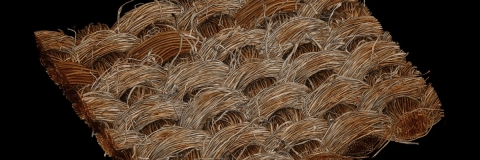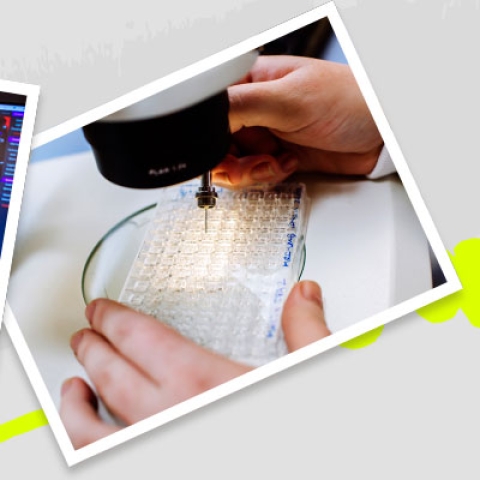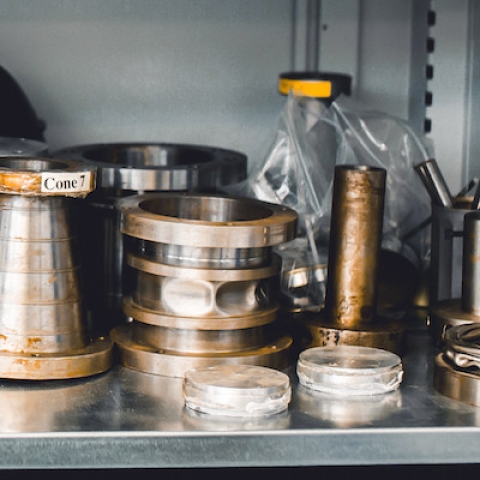
About CoMic
The Correlative and Multimodal Microscopy (CoMic) Research Group brings together expertise in imaging, spectroscopy, scattering, and diffraction techniques to enhance material and process characterisation across multiple scientific disciplines.
Our research focuses on integrating complementary microscopy techniques to extract deeper insights than a single method alone, advancing both fundamental science and applied research. We also explore the development of software and hardware solutions for data acquisition, image analysis, and multimodal data integration.
Whilst CoMic works across numerous scientific disciplines, our recent focus has been on the life sciences.
Researchers interested in correlative and multimodal workflows are encouraged to engage with the group, whether through active research participation, knowledge sharing, or collaborative projects.
Contact us
To find out more about our correlative and multimodal work, the equipment we use, and for collaboration opportunities and commercial services, please contact:
Dr Charles Wood
The Correlative and Multimodal Microscopy (CoMic) Research Group leader
charles.wood@port.ac.uk
Techniques
The correlative and multimodal workflow depends upon the types of samples and their research questions. Workflows may, therefore, look very different from project to project. Sample preparation, which is often overlooked, is incredibly important when exploring correlative and multimodal workflows. You can read more about some of the individual techniques below.
X-rays are useful because they can pass through matter, allowing internal structures to be visualised that would otherwise be hidden. This can be a good place to start a correlative workflow, using what’s called a ‘global’ scan to characterise an entire sample and create a 3D digital copy. Regions of interest within a sample can then be identified, and subsequent higher-resolution X-ray scans may follow which focus on those smaller regions. This is something regularly performed within the Additive Manufacturing and X-ray Microscopy Laboratories at the University's Future Technology Centre.
X-ray microscopy isn’t a purely non-destructive technique, as sometimes regions within a sample may need to be removed for experimental simplicity. Furthermore, the X-rays themselves may also cause degradation of the sample. However, since large samples (mm to cm) can be processed at spatial resolutions ranging from hundreds of microns to tens of nanometers, it’s an extremely versatile technique.
Imaging isn’t the only thing you can do with X-rays, of course, and there are a variety of spectroscopic techniques, such as X-ray Absorption Spectroscopy (XAS) and X-ray Photoelectron Spectroscopy (XPS), and scattering-based techniques, such as X-ray Diffraction (XRD) and X-ray ptychography. To read more about some of these techniques, and others, visit the Diamond Light Source website.
Sometimes higher spatial resolutions are needed, and this is where electron microscopy (EM) finds its place in the correlative workflow. Surface features measuring a few tens of nanometers can be imaged using scanning electron microscopes (SEMs), whilst transmission electron microscopes (TEMs) can show the internal structures of thin slices with spatial resolutions of a few nanometers. Most high-end SEMs and TEMs also have analytical subsystems, with the capability to perform Energy Dispersive Spectroscopy (EDS) for chemical and elemental analysis, and Electron Backscatter Diffraction (EBSD) for microstructural characterization.
Electron microscopy is not just a 2D technique either, with 3D electron microscopy (VolumeEM) achievable through techniques such as Focused Ion Beam SEM (FIB-SEM), Serial Block Face SEM (SBF-SEM), Array Tomography, and Serial-Section SEM/TEM. Though the sample volumes that can be characterised with EM (microns to mm) are typically smaller than for X-ray microscopy, the ability to perform imaging with EDS and EBSD in a laboratory setting makes EM a powerful tool for correlative multimodal studies.
Sample preparation is key for EM, particularly for biological samples, with osmium typically being used to enhance contrast (double osmication is sometimes required). High-pressure freezing capability is often preferred for biological samples, to ensure ice crystals do not interrupt microstructure, and it can be difficult to characterise live systems due to the requirement for EM to operate under vacuum (unless access to an Environmental SEM is available). These aforementioned considerations often necessitate personnel to be skilled in both sample preparation and EM characterisation techniques.
Alternatively referred to as light microscopy, this technique uses photons with wavelengths in the approximate region of 360-700 nm in combination with various lenses, apertures, and detectors. There are many subtypes, described further on the ioLight website.
The highest spatial resolutions tend to be in the hundreds of nanometres range, depending upon the wavelength of the light source. Super-resolution microscopy can achieve resolutions in the tens of nanometres range, with techniques such as Stochastic Optical Reconstruction Microscopy (STORM), Structured Illumination Microscopy (SIM), Near-field Scanning Optical Microscopy (NSOM), and Stimulated Emission Depletion (STED) to get around the diffraction limit.
Relatively large samples (cm) can be mounted in a light microscope, depending upon its design, however, the field of view is limited by the magnification of the objective lens. An example from a compound light microscope would be using a 10x objective to achieve a field of view (FOV) with a circular diameter of approximately 2 mm (100x), whilst for a 100x objective the FOV diameter would be approximately 0.2 mm (1000x). Sample preparation is important for optical microscopy, particularly for the life sciences, where samples are often stained with fluorophores for fluorescent labelling in biological analysis. You can read more about sample preparation on the Leica website.
Optical microscopy has also found widespread use alongside electron microscopy. Known as correlative light electron microscopy (CLEM), it combines the high resolution of electron microscopy with a fluorescence microscope for regions of interest. To learn more about CLEM visit the Oxford Instruments Learning Centre.
Confocal laser scanning microscopy (CLSM) and light-sheet fluorescence microscopy (LSFM) also enable samples to be characterised in 3D.
When an even higher resolution is required Atomic Force Microscopy (AFM) can be useful. Utilising an atomically sharp tip mounted onto a cantilever, which is scanned across a surface, atomic forces between the tip and sample cause it to move up and down. These movements are used to build a map of the surface topography. Unlike light microscopes that are diffraction limited, AFM is only limited by the radius of the tip, meaning nanometre resolution is possible in three dimensions.
Samples for AFM are typically smaller than those used in X-ray and electron microscopy, and they must also be flat to allow the tip to maintain good contact during imaging. The field of view is often much smaller, with maximum scan sizes often being around 100 µm; however, the technique offers higher resolution and true three-dimensional data sets.
AFM allows for the mechanical properties of a surface to be measured by collecting a force curve, where the probe is pushed into the surface in a controlled manner, and bending of the cantilever is monitored. With careful calibration, this data can be fitted to measure properties such as Young's modulus and adhesion. In addition, the tip material can be changed to produce maps of other surface properties. This is the basis of techniques such as magnetic force microscopy (MFM), conductive AFM (c-AFM), Kelvin Probe Microscopy (KPFM), and many others.
There are many other techniques to consider that could be included here, but for now a quick summary of some should hopefully suffice. More will be added later as CoMic develops.
Neutron microscopy is also useful for looking at entire samples, particularly for lighter atomic elements, such as hydrogen and lithium, that do not absorb X-rays very much. Combining neutron and X-ray microscopy can be a really useful correlative route for gaining unique insights into certain samples. These kinds of investigations are performed at national facilities, like the UK’s neutron and muon source, ISIS. See also previous CoMic presentations on neutrons for archaeology, palaeontology, materials science, food science, and medical devices.
Nuclear Magnetic Resonance (NMR), whether for imaging or spectroscopy, is not limited by penetration depth, unlike X-ray photons, and thus NMR is very useful for certain applications. However, the sensitivity of the technique is broadly dependent upon the magnetic field strength and the presence of nuclides within a sample environment susceptible to magnetic fields. Contrast agents can be used to overcome some of these limitations. Perhaps most commonly associated with the medical field for characterising soft tissues, NMR can also be used for investigating flow in porous media, assessing saturation and wetting properties, and for monitoring structural changes due to a chemical environment.
Ultrasound (acoustic) microscopy is another example of a technique that is perhaps better known for medical applications, but is equally applicable to other scientific disciplines. It has the advantage of being fully non-destructive, and the experimental set-up is relatively less complex, with transmitters and receivers accommodated into a single scanning unit and the sample usually immersed in water. Modern acoustic microscopes typically operate at frequencies between 30 MHz and 2 GHz, and can provide large scale (cm range) structural and anisotropic elastic properties with a spatial resolution in the micrometre regime, though penetration may be limited by the attenuation at high frequencies. Similar to acoustic microscopy, medical ultrasound also relies on ultrasound propagation and uses a handheld transducer that operates at lower frequencies, typically from 1 MHz to 15 MHz, providing real-time images up to about 20 cm in length. Ultrasound is ubiquitous in healthcare due to the unique combination of it being portable, radiation-free, and providing real-time characterisation.
Using all of these separate techniques is great, but without the hardware to enable the acquisition of data correlative multimodal workflows wouldn’t exist. A sometimes forgotten aspect of correlative microscopy, hardware plays a vital role. Perhaps as diverse as CoMic is broad, there are many hardware aspects to consider, including precision and repeatability. A first step to consider is the sample holders used in each technique, and how these are then transferred between different pieces of equipment.
Another important part of CoMic is to understand the difference between data and information. CoMic workflows generate a lot of data, but isolating the necessary information is difficult. Software solutions that can help with things like image registration, segmentation, and quantitative analysis are paramount. There are several existing packages aimed at doing just this, including Oxford Instruments' Relate, and Zeiss’ ZEN Connect.
Group Members
- Dr. Charles Wood, CoMic Research Group Lead
- Dr. Atousa Moayedi, UKRI-funded Postdoctoral Researcher
- Mr. George Deakin, Zeiss-funded PhD student
Explore more research
Research and innovation
Find out more about research opportunities at Portsmouth, and how you can help us tackle the planet's most urgent challenges. Start your research journey today.

Mechanical and Design Engineering
Explore the work we're doing in Biomedical Engineering and Materials Engineering – our two areas of expertise in Mechanical & Design Engineering research.

